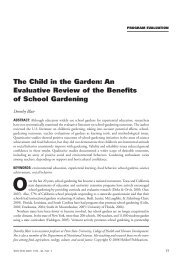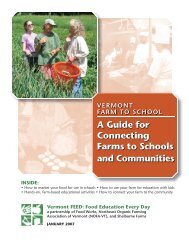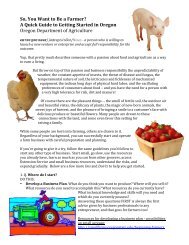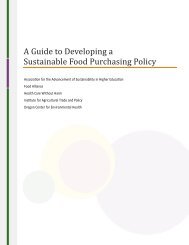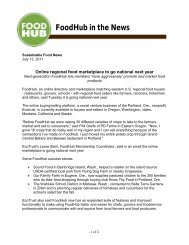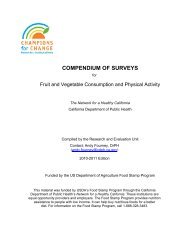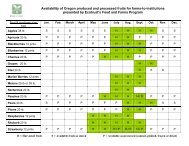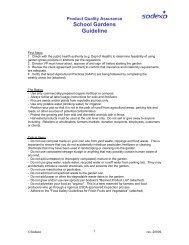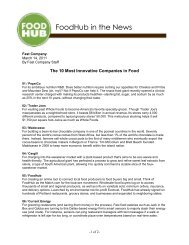eval report cover.indd - New Jersey Farm to School Network Wiki
eval report cover.indd - New Jersey Farm to School Network Wiki
eval report cover.indd - New Jersey Farm to School Network Wiki
Create successful ePaper yourself
Turn your PDF publications into a flip-book with our unique Google optimized e-Paper software.
Review of <strong>Farm</strong> <strong>to</strong> <strong>School</strong> Evaluation Literature►In the Santa Monica-Malibu <strong>Farm</strong>ers’ Market Salad Bar program (SMM-CA),the number of students choosing a salad bar lunch jumped by over 500% whenfruits and vegetables from the farmers’ market replaced produce from the existingsupplier. 83Financial viability of food service operations<strong>Farm</strong> <strong>to</strong> school programs generally serve fresh produce and other products that requireadditional cleaning and food preparation, potentially leading <strong>to</strong> higher labor costs. Foodfrom local farms may also be more expensive than similar items procured from largedistribu<strong>to</strong>rs. In order <strong>to</strong> expand farm <strong>to</strong> school programs <strong>to</strong> more schools and <strong>to</strong> institutionalizefarm <strong>to</strong> school meals as permanent fixtures in school cafeterias, it is critical <strong>to</strong>understand the costs associated with farm <strong>to</strong> school and <strong>to</strong> develop strategies <strong>to</strong> makethese programs financially self-supporting. <strong>Farm</strong> <strong>to</strong> school programs often require amodest initial investment of money for equipment at each school site.►VEN-CA <strong>report</strong>ed initial start-up costs in the range of $3,400 <strong>to</strong> $7,000 perschool site <strong>to</strong> buy equipment such as child-sized salad bars or extra refrigera<strong>to</strong>rspace. 49Cost of farm <strong>to</strong> school mealsResults from five studies show that farm <strong>to</strong> school meals typically cost more <strong>to</strong> preparethan non-farm <strong>to</strong> school meals.►►►►During the 2004-05 school year, the overall cost per meal for farm <strong>to</strong> schoolsalad bar meals in the CLP-CA was $2.71/meal vs. $2.27/meal for the non-saladbar meals. With income per meal at $2.14, each salad bar meal represented aloss of $0.58/meal and each non-salad bar meal represented a loss of $0.13/meal.Th e overall food costs in 2004-05 were about 21% higher for the salad bar mealsat $1.52/meal vs. $1.26/meal for non-salad bar meals (a $0.26 /meal difference).Labor costs were $0.80 per meal for a salad bar meal compared <strong>to</strong> $0.61 per mealfor non salad bar meal, a difference of 30% or $0.19 /meal. 19In COM-CA, food ingredients for farm <strong>to</strong> school salad bar meals cost an averageof $0.13 more per meal than hot meals. Labor costs at two farm <strong>to</strong> schoolsites were $0.64 and $0.48 higher per meal than two comparative non-salad barschools. 20Per-meal preparation costs of salad bar meals in a VEN-CA elementary schoolwere $1.19 (excluding protein-rich items) compared <strong>to</strong> $1.20 for a hot meal. 49AES-OR <strong>report</strong>ed that the cost of goods for the cooked-from-scratch meals attheir school was lower than at other schools in the school system ($0.94 versus$0.99). However, labor costs were much higher at the pilot school, increasingthe <strong>to</strong>tal cost per meal <strong>to</strong> $3.52 versus $1.67 for the control school. It should benoted that volunteer labor and food donations were estimated at a market valueand were included in all calculations. When district level administrative costswere included, both pilot and non-pilot schools posted a deficit. 4544 Bearing Fruit: <strong>Farm</strong> <strong>to</strong> <strong>School</strong> Evaluation Resources and Recommendations



